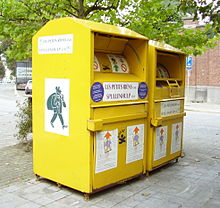
Back Recyklace textilií Czech Textilrecycling German Ανακύκλωση υφασμάτων Greek Reciclaje textil Spanish Recyclage textile French Textilanyagok újrahasznosítása Hungarian Textielafval Dutch Reciclagem têxtil Portuguese Переработка текстиля Russian Textilný odpad Slovak

| Part of a series on |
| Clothing and the environment |
|---|
| Environmental impact of fashion |
Textile recycling is the process of recovering fiber, yarn, or fabric and reprocessing the material into new, useful products.[1] Textile waste is split into pre-consumer and post-consumer waste and is sorted into five different categories derived from a pyramid model.[2][3] Textiles can be either reused or mechanically/chemically recycled.[4][5]
There has been a shift in recent years toward recycling textiles because of new regulations in several countries.[6] In response, companies are developing products from both post-consumer waste and recycled materials such as plastics. Results from academic studies demonstrate that textile reuse and recycling are more advantageous than incineration and landfilling.[7]
- ^ Hawley, J. M. (2009-01-01), Blackburn, R. S. (ed.), "8 - Understanding and improving textile recycling: a systems perspective", Sustainable Textiles, Woodhead Publishing Series in Textiles, Woodhead Publishing, pp. 179–199, ISBN 978-1-84569-453-1, retrieved 2022-11-04
- ^ Hawley, J. M. (2006-01-01). "Textile recycling: A system perspective". In Wang, Youjiang (ed.). 2 - Textile recycling: a system perspective. Woodhead Publishing Series in Textiles. Woodhead Publishing. pp. 7–24. doi:10.1533/9781845691424.1.7. ISBN 9781855739529. Retrieved 2019-11-08.
{{cite book}}:|work=ignored (help) - ^ Cite error: The named reference
:10was invoked but never defined (see the help page). - ^ Cite error: The named reference
:0was invoked but never defined (see the help page). - ^ Cite error: The named reference
:6was invoked but never defined (see the help page). - ^ Cite error: The named reference
:13was invoked but never defined (see the help page). - ^ Cite error: The named reference
:14was invoked but never defined (see the help page).
© MMXXIII Rich X Search. We shall prevail. All rights reserved. Rich X Search